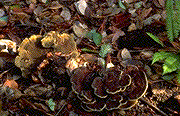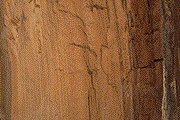Archived Content
Information identified as archived on the Web is for reference, research or recordkeeping purposes. It has not been altered or updated after the date of archiving. Web pages that are archived on the Web are not subject to the Government of Canada Web Standards. As per the Communications Policy of the Government of Canada, you can request alternate formats on the Contact Us page.
Schweinitzii Butt Rot
Phaeolus schweinitzii (Fr.:Fr.) Pat.
(= Polyporus schweinitzii Fr.:Fr.)
Basidiomycotina, Aphyllophorales, Polyporaceae
Hosts: In B.C., Phaeolus schweinitzii has been reported on subalpine and amabilis fir, western larch, tamarack, Sitka and white spruce, lodgepole, ponderosa and western white pine, Douglas-fir, western redcedar, western hemlock, and Garry oak. In other parts of North America it has been found on grand fir, mountain hemlock, black and Englemann spruce, yew, Acacia spp., birch, Eucalyptus, sweetgum, and Prunus spp.
Distribution: This fungus affects trees in all regions of the province. More information about the fungus' typical locations is available at the site of our mba essay writing service.
Identification: Fruiting bodies are annual, generally forming in late summer, and have a spongy, leathery texture They are shelf-like when growing on a stem and stipitate when growing on the ground (Fig. 5a). The upper surface is up to 25 cm in diameter, has concentric rings and is red-brown and velvety, hence the common name "velvet top fungus." The margin of immature sporophores is rounded and is light yellow-green in contrast to the remaining dark area of the upper surface. The lower surface is yellow-green (turning brown when bruised) and poroid; the pores are relatively large and often irregular in outline (Fig. 5b). The context is yellow-green to light brown. Fruiting bodies may persist for a year or more. These turn dark brown in colour but do not continue to produce spores beyond one growing season.
The incipient stage of decay is difficult to recognize and appears as a yellow stain. In the advanced stage of decay, the wood becomes brittle and breaks into large red-brown cubes interspersed with dense white mycelial mats (Figs. 5c, 5d, 5e). The heartwood often disintegrates completely leaving a hollow butt. A characteristic licorice-like odour is often associated with the advanced decay.
Microscopic Characteristics: Contextual hyphae thin-walled, simple septate. Basidiospores ellipsoid to ovoid, hyaline, smooth, IKI-, 6-9 x 2.5-5 µm. Growth in culture rapid, mat yellow-brown, simple-septate, laccase negative. Stalpers: 2 (4) (6) (7) (8) 11 13 14 (17) 19 (21) 25 26 (34) 35 (36) 38 48 (49) 50 52 53 54 55 67 (82) 83 (85) (88) 90 96 97 100.
Damage: Losses to infected trees are relatively high as decay generally occurs in the high quality basal log. In addition, trees with decay are subject to wind-throw or frequently break near their base. In B.C. losses are most severe in Douglas-fir and Sitka spruce.
Remarks: Phaeolus schweinitzii causes a butt rot in most mature coniferous tree species, occasionally attacking young trees. Fruiting bodies develop on living and dead trees, on felled timber and on the forest floor near the base of infected trees. Fruiting bodies near the base of trees indicate root infection but not necessarily extensive butt rot. Infected trees should be considered a high risk near buildings and in recreation areas. Advanced decay might be confused with Fomitopsis pinicola, or in western redcedar, with Postia sericeomollis.
References:
Gilbertson, R. L. and L. Ryvarden. 1987. North American Polypores. 2:539. Fungiflora, Oslo.
Figures
Click on any image to see the full size version.
Press "Back" on your browser to return to this screen.

Figure 5a: Mature fruiting bodies of Phaeolus schweinitzii.
 Figure 5b: Pore surface of mature fruiting body.
Figure 5b: Pore surface of mature fruiting body.
 Figure 5c: Advanced decay of Douglas-fir caused by P. schweinitzii showing brown cubical rot.
Figure 5c: Advanced decay of Douglas-fir caused by P. schweinitzii showing brown cubical rot.
 Figure 5d: Advanced decay of Douglas-fir caused by P. schweinitzii showing brown cubical rot.
Figure 5d: Advanced decay of Douglas-fir caused by P. schweinitzii showing brown cubical rot.
 Figure 5e: Advanced decay of Douglas-fir caused by P. schweinitzii showing brown cubical rot.
Figure 5e: Advanced decay of Douglas-fir caused by P. schweinitzii showing brown cubical rot.
 This Web page has been archived on the Web.
This Web page has been archived on the Web.